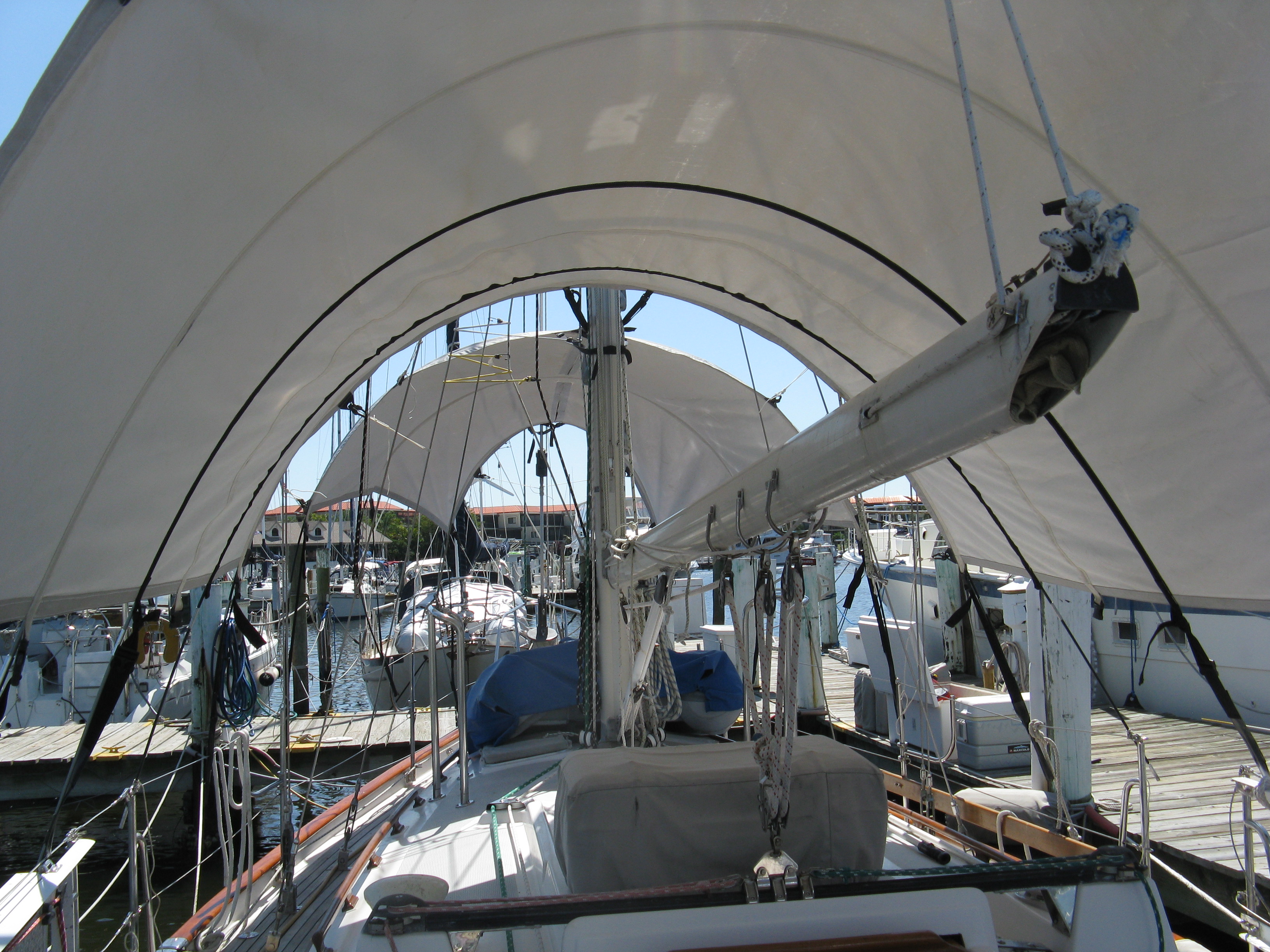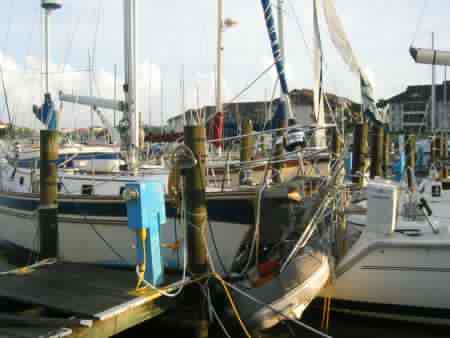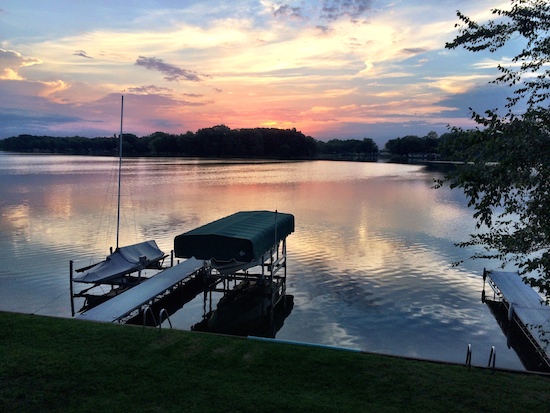This article written by Jan S. Irons appeared in Blue Water Sailing in the spring 2009. Unfortunately I don’t have the real “reprint” to post, but this checklist provides valuable information on things to think about before leaving your boat for hurricane season if you are not in a hurricane zone. Much of this information is also covered in the Hurricane Preparedness series, and the rest will be covered in other more in depth posts about leaving your boat, but since it’s that time of year (spring 2011) I thought I’d post the original article in Bluewater Sailing.
*********
Checklist To Leave Your Boat Out of a Hurricane Zone
More and more cruisers are discovering the joys of cruising for six months a year, leaving the boat to return to their families during hurricane season. Successfully leaving your floating home in paradise requires preparation. Mold and mildew, critters, roaches and other undesirables are waiting to invade, but combining a bit of luck with a lot of preparation has kept our 1985 Passport 37, Winterlude, in cruise ready shape through hurricane seasons in the Rio Dulce, Guatamala, Bocas Del Toro and Colon Panama. All the marinas are located safely out of hurricane range, so these preparations do not include getting ready for a potential hurricane! We allow at least a week for all our preparations, here is our checklist:
1. Dehumidifier … in the heat and humidity of the tropics, a dehumidifier works wonders. Two keys to success:

A. Never set it lower than about 50%, ours is set between 55 – 60% humidity. A common mistake is to set the humidity level below 50% — the risk is drying out so much that you return to cracked wood on your salon table, nav table and elsewhere. Not pretty!
B. Everyday dehumidifiers are not particularly suitable for marine life. Every time the power blips, or goes off, a “regular” dehumidifier turns itself off and will not restart without human intervention. With power blips sometimes daily, this is simply not practical outside the U.S. no matter how much you pay a caretaker. Spend the extra money and buy a stainless steel marine dehumidifier that automatically restarts whenever the power returns. Aboard Winterlude, we consider the $350 investment in a stainless dehumidifier one of our best decisions.
C. Our dehumidifier lives beside the galley sink, draining into the sink and out the sink throughhull. Advantages: no draining a built-in pan and no extra water in the bilge in case of a bilge pump failure.
2. Hire a Caretaker. Do not underestimate the value of a caretaker. In the past our task list for caretakers has varied widely. Currently our caretaker visits the boat once a week, opens it up, checks for beginnings of mold, mildew, insects or leaks, insures the dehumidifier is humming away, checks the bilge and reports anything he finds to the yard manager. The yard manager will call us or e-mail if anything is amiss and together we will formulate a plan to get it fixed before it creates major havoc. In the past, with the batteries connected, we had the caretaker check the batteries and flip on the battery charger when necessary. On the hard this year, the batteries are disconnected
3. Critter & Bug Control … preparation and a bit of luck have combined so that Winterlude has never had a bug/critter infestation …
A. Get Rid of ALL Food Aboard … some years we take this literally and some years we’ve left spices and a few canned goods. Dry goods can attract weevils and other uninvited critters and bugs. One year we made the mistake of leaving soda cans below floorboards. The thinner foreign cans chafed through leaving a sticky mess. Luckily our caretaker cleaned it up before we had unwanted visitors.
B. Thoroughly clean out the refrigerator, freezer and pantry areas with a bleach solution. Clean the oven and stovetop squeaky clean – also below and behind the stove, anywhere food spatters might have escaped and hidden over the course of the cruise.
C. Wipe down the entire interior of the boat … we have teak, so I use Murphy’s Oil soap to clean the walls, floors, head and every interior surface.
D. Ant Traps/Roach Traps … until reaching Panama, where roach traps were unavailable, we liberally left these traps everywhere – especially anywhere dark – inside lockers, etc. In Panama I was able to buy boric acid at the pharmacy and plastic water bottle caps provided a good container.
E. Bounce Sheets … we leave dryer sheets in our drawers, in hanging lockers and under salon cushions and mattresses.
4. Ventilation. Airflow through the boat is critical even when the boat is completely locked during storage. We have open dorades providing airflow in and a solar powered vent set to suck air out.
A. Stuff an air permeable rag in any opening that a critter or insect might crawl up to discourage entry. We put rags in our dorades as well as any openings in the anchor locker and elsewhere. Hopefully air gets through and critters don’t!
B. Leave all locker doors open for additional ventilation. We also leave all floorboards and storage area lids – for example, under the settees, sideways to allow for airflow. Cushions and mattresses are positioned up so nothing is laying flat.
5. Diesel. Every cruiser has a different routine for their diesel and we have used several ourselves. Currently we fresh water flush the diesel, shut all seacocks, change the oil and shut it down for the six months. In the past, we had a caretaker start the boat once every couple of weeks, and that was always satisfactory. We top off our diesel tanks before leaving to prevent condensation. (NOTE: We have a fuel polishing system and will run it extensively upon returning.)
6. UV Protection. Harmful UV rays are especially a problem in the tropics. We put an extra coat of wax on our deck and hull, carefully touch up any dings in the teak and apply two more coats of cetol gloss. All stainless is polished and a protectant applied. The dinghy and kayaks get thoroughly cleaned, two coats of 303 Aerospace UV protectant applied and stored under canvas. The boat is covered … on the hard, we utilize a full cover with space under to walk and ventilate, in a marina, we use two Shadetree awnings.

7. Shut All Seacocks except the one to the sink. When the boat is left in the water the bilge seacock is also open. Winterlude has a plug in the bottom of the keel that we leave open when on the hard. It drains any water accumulating in the bilge and allows us to leave the batteries disconnected.
8. Disconnect All Electronics. On the hard, our batteries are topped off then disconnected, allowing us to shut off all electricity to the boat. The dehumidifier is plugged into shore power with an extension cord. We aren’t as thorough as some boats on this point, but we disconnect the SSB & VHF radios – and store them in the oven for lightning strike protection. We disconnect the radar, radio from power. The SSB antenna is disconnected at the backstay. We also take all the AA, AAA, C or D batteries out of anything left on the boat.

9. Clean and Store. Sails are freshwater washed and hoisted on a calm day to let dry before removing and storing below. Canvas is freshwater rinsed, dried and stored below. Dive tanks are emptied and stored, the fishing gear is all stowed, wetsuits, BCDs, fins and masks are thoroughly cleaned and dried before storage. In addition …
A. Freshwater rinse & dry anchor, kellet, anchor chain and rode as well as the entire anchor locker.
B. KISS Blades are washed and stored below.
C. Clean the bottom and if the boat’s to be left in a marina, arrange for regular bottom cleaning. In Bocas Del Toro, we even had the prop bagged because of the rampant marine growth.
D. Make sure everything is out of the cockpit and stowed below – especially electronics and remote VHF mikes.
E. Clean and dry the bilge – YUCK, neither of us likes this chore!
F. Pickle the watermaker, clean and/or change filters.
G. Put a rag in anything birds, critters, wasps or insects could invade – the end of the boom, the anchor locker area, etc.
H. Check and clean all propane connections for corrosion and refill the propane tank if needed.
I. Run all the gas out of the Honda 2000 generator, change the oil and store below.
10. Outboard Engine. Our trusty Tohatsu 8 hp is fresh water flushed to let the gas run completely out, lower unit oil changed as necessary, cleaned and 303 UV protection applied. We lock it to the rail with a bar lock such as a MasterLock Bar and cover it with canvas. One caution … LOCKS in the tropics can be a problem. The first year we left Winterlude in the Rio Dulce, our biggest headache was arranging ransom for the lock holding our outboard hostage to our rail. Lubrication of all possible types to hacksaws didn’t have any effect and three days later we were seriously considering hiring a thief to steal our outboard so we could buy it back! Since then, we are much more careful about our locks. We use only stainless marine locks and spray them every few weeks with Tri-Lube Lubricant, the only lubricant we tried that has that’s kept them corrosion free. Before leaving we literally soak all locks in Tri-Lube.
11. LOCK EVERYTHING! Most theft in paradise is opportunity theft. Choose your marina carefully and make sure you ask about security. If you are not comfortable, choose another location. Most marinas and yards have excellent security, but some have issues and asking around with other cruisers in the area will bring these to your attention. Leave nothing available – make sure your cables for anything left out are substantial enough to resist a pair of bolt cutters.
Finally we, drop a chain over the side into the water as the final measure of our lightning protection plan, lock the companionway and bid our floating home goodbye for a few months.
Enjoy your visit in the U.S. without worrying about your boat!













